Abdellah Karroum is a Moroccan independent art researcher and curator based in Paris, France and Rabat, Morocco. Karroum founded L’appartement 22 in 2002, the first independent experimental space in Rabat, which inspired the formation of a number of artist-run spaces in Morocco. Nationally as well as internationally acclaimed artists, writers, and filmmakers, including Adel Bdessemed, Doa Aly, Hamdi Attia, Fouad Bellamine, Faouzi Laatiris, Cécile Bourne-Farrell and others have left their mark on L’appartment 22. In addition, Radioapartment22, an experimental online radio, provided the space with a platform for hosting equally significant projects over the past decade.
Between 1993 and 1996, Karroum served as the assistant curator at the CAPC Musée d’art contemporain de Bordeaux in France. In 2006 he was appointed associate curator of the DAK’ART Biennial for African Contemporary Art in Senegal; later in 2008 he became co-curator of the Position Papers program for the Gwangju Biennale, and in 2009, the curator of the 3rd AiM International Biennale in Marrakesh, followed by the curatorial project “Sentences on the Banks and other activities” in Darat Al-Funun in Amman, in 2010.
This past summer, Karroum curated the Working for Change project for the Moroccan Pavilion at the 54th Venice Biennale. This research and action-based project focused on producing artworks and sharing documents. After a research period in the Rif (Morocco), the project continues in Venice with the aim of proposing and studying connections between artistic production and social contexts. Morocco’s example proved significant here at the artistic and political levels, as seen in each of the proposed artworks. This curatorial project’s “practive” approach–which involves the joining of the practice of art as research to its appearance as active production (practice + active)–seeks to activate projects, including several collaborations in Morocco with feminists and other activists.
As for what’s ahead, mark your calendar for Intense Proximity , La Triennale 2012 opening on April 20 at Palais de Tokyo in Paris. The artistic director Okwui Enwezor invited Melanie Bouteloup, Emilie Renard, Claire Staebler and Abdellah Karroum to build a project, whose fundamental goal is to effect a shift away from the idea of national space as a constituted physical location to a frontier space that constantly assumes new morphologies and new models of categorization (local, national, trans-national, geo-political, denational, pure, contaminated, etc.).
All said, the conversation that follows epitomizes the direction I plan for this column to follow in 2012. It feels like this is only the first hint at an ongoing dialogue propelled by art and ideas that can’t yet be concluded – and that’s the bright side of this interview.
I am most pleased to present to you Abdellah Karroum.
Georgia Kotretsos: I would like to begin our discussion by talking about the location of the “art-space” – the journey, or better yet, the route that leads us to art and then back to where we came from. What one sees before, during and after viewing a work of art often becomes part of the overall experience. L’appartement 22 impresses me as a creative outpost, in place of an apartment, a studio, an office, an exhibition space and an observatory facing politics, i.e. the Moroccan Parliament and what unfolds before it. What role has this potent backdrop played in the discussions, projects and outcomes achieved at L’appartment 22 over the past decade?
Abdellah Karroum: Your question inspires me to go on a physical and mental “expedition” to write a novel, mixing memories of facts and projections of possibilities right now. If I could make time, I would sit in one place and write it – just like that, to tell the story of this journey, where its end remains unknown.
If you had asked me the same question two years ago, I would respond using different intellectual and theoretical routes, in connection to where the curatorial work was situated.
A space where art “happens” does not exist in and of itself. A place is defined by its activity. Physicality is only possible with activity, which means the journey cannot be defined in advance, no time for tomorrow. The projection of the route has its reality in the present, not in the future. This being said, we also have places of investment where we think we meet certain expressions, or where we think we are more inspired to read the worlds through the vocabulary and prism of art.
Perceiving and seeing have different meanings in different conceptions of vision and the visible. What we see continues to provoke “images” during and after the “encounter;” in the meantime, what we perceive is a combination of what we saw before and what we are encountering here and now. Art activity is part of a continuous revolution, and this is why I am interested in the processes and approaches of artists that experiment with a “formactive” [1] vocabulary and take risk with formulating proposals in a different place in the world than the space predefined by the institutions of the art world.
L’appartement 22 became a destination not only to see physical artworks produced for the exhibitions, but to witness the transformation of that exact place into something else, from a private apartment to a place of public engagement. L’appartement 22 is situated on the avenue Mohamed V, facing the Parliament building of Morocco. The police force residents in the area to close the windows throughout the entire avenue facing the parliament for one day every year – when the king opens the first session of parliament.
At this exact moment, the space inside the “apartment” becomes dark, separated visually from the outside. What this violent gesture provokes, though, is the opposite of what the power wants to project. When the windows are closed, a pinhole remains from an artist’s project on the blinds that have been forcefully closed.[2] The space becomes a camera-obscura, making a projection of the entire landscape, including an upside-down image of parliament inside the space of L’appartement 22. The sound continues with more echoes from outside on the street. We are still in the same space, and feel the physicality of the situation outside with even greater clarity. The senses of sight (the visible) and vision meet in this circumstance, creating a stronger consciousness, as the hyper-reality of this one place brings us closer to an awareness of the broader context.
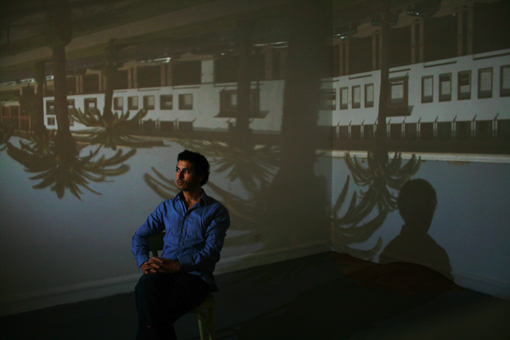
Parliament of Morocco and Avenue Mohamed V in the darkness of L'appartement 22's space as a camera-obscura, 2011. Dispositive remains from Jérôme Schlomoff’s workshop project. Courtesy of L'appartement 22.
L’appartement 22 started and continues to exist in conflict at different levels, with both the concept of art history and its definitions, and with Moroccan power, as we realize that the state in its advanced decomposition of political powers has no hope of recovering a sense of responsibility. I just started to work with artists, theorists, and friends in a parallel space we created, while at the same time saying aware of the ethics of production of any kind.
GK: Working for Change, the project for the Moroccan Pavilion at the 54th Venice Biennale 2011, merged the curatorial office with the artist’s studio. In your essay SENTENCES on the banks and other ACTIVITIES, you define the contemporary exhibition space as such: “Today the exhibition space is for the curator what the studio is for the artist: a nomadic mental space, more an imprecise field for ideas than a factory for objects.” If there were one person who’d command all of us in the art world to write this down 100 times, I’d promptly tune up again with my optimistic side. I’m on your side, but aren’t such exhibition spaces still the exception, or are we talking about different art worlds altogether?
AK: The Biennale is supposed to be a place for debate, at least in theory, as it is a place where artists, theorists, and producers are supposed to meet and confront their concepts and proposals. The position of this project was precisely to create a place where we could denounce the spectacle of the art system and the absurdity of national representations. So the trip to Venice was one part of the project, and we stayed for three months, from June to August 2011. The set up was a base, organized in such a way that the same space could be shared – permitting visitors to see artists’ projects while curators continued working. No walls were built, and no artworks were installed on the existing walls. The only object fixed on the wall was a TV monitor connected to a satellite antenna. We always had fruit and drinks for the curatorial team, the artists, and those visitors who stopped and asked more about the project. Some visitors just crossed the space toward the courtyard, to see the permanent studios of local artists and architects. This part of the project was made for the city of Venice, and not the Art World of Venice. I realized how much the machine of the Biennale could be estranged from the realities of the city, especially its younger generation of artists who are, by tradition, transformed into assistants for national pavilions. It reminded me of Marrakech, when the residents were all engaged to provide the tourist industry with quick services.
Again, “Working for Change,” between the Rif Mountains, Venice, and Rabat, is a project addressed to both the Biennale and as a place for discussion. Through this, we find a way to interrogate the relation of art to politics. At the same time, the project was a framework for research and action in different geographies.
Today, we find ourselves in the midst of a very important turn where we are both witnessing and participating in the reformulation of the role of cultural practices in the world, especially in relation to the museum and its tentacles. The idea is not new, but the real rupture is that this is happening both inside and outside the so-called “art world.”
We cannot ignore what is happening: the attempts to connect expression and its formulation of the subject, or to translate an object into knowledge.
History needs change to start somewhere. It needs the identification of a place and a real fact. The convention says that the Revolution started in a small village in Tunisia, with a young man immolating himself. Humans need to understand their surroundings and they create stories, while the reality is otherwise. The same act happened tens of times in Morocco, Egypt, China, and other countries both now and in the past… and the fight for social justice has been going on for much longer than a decade all over the world. Today we are in a fragile moment when art institutions face a dilemma between programming and creating something that is not there. Who wants to take the risk? To be sure, it is not the bureaucratic museums. The Palazzo Riso, where I had an exhibition last year, was closed in January 2012 because the European funding was cut. No one in Sicily was ready to invest in its own local tools for culture, for education. Local circumstances, the proximity in this case provided by the institution of art with the locals, is eaten by global priorities, here of broader European management. (“Money eats soul,” as Rirkrit Tiravanija would say).
GK: La Triennale of Paris 2012 is just around the corner. Okwui Enwezor is leading this curatorial pentad made up of Melanie Bouteloup, Emilie Renard, Clair Staebler and yourself. Your goal, most importantly, is to create a space of intellectual generosity. How did you go about reaching this outcome? What methods have you employed so far?
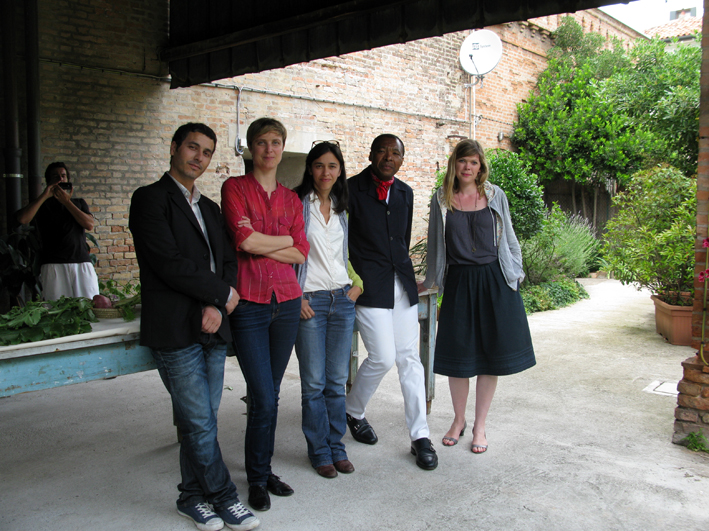
From left to right: Abdellah Karroum, Émilie Renard, Melanie Bouteloup, Okwui Enwezor, and Clair Staebler, Venice, 2011.
AK: The challenge for curators with such a project is to make an artistic project from what is planned as a state event: how to make it yours, with what you believe would contribute to society in a constructive way? The political situation in France is complicated, and a significant part of its leadership has a poor imagination. Not only are many politicians living in perpetual amnesia, but they also remain ignorant of the present, and what exchange means. With the “Intense Proximity” project for La Triennale the curators have a daily discussion, and also exchanges with different artists and intellectuals around the globe about ideas, to make the intellectual generosity we are talking about a reality. An exhibition is never empiric: we introduce about two hundred artworks while we discuss thousands. What is left behind in our research archive and notebooks, and in artists’ studios, is as important as what is in the exhibition itself. This is why we say that the negotiations within a large-scale exhibition such as La Triennale consist of opening ways for the process to be continued, by each of us or by others in different spaces. And we are already in that space of dialogue.
GK: Last year you traveled in Africa, America, Asia and Europe, where you visited the studios of numerous artists. What were you after, and what did you discover during the process? Also, speaking of traveling and studio visits, how about visiting Athens in the near future–how about that?
AK: I would love to visit Athens. I have relatives in Greece, from the times when no visa was needed to travel between Athens and Tingis. My ancestors were circulating in the deserts of Africa and also in the big blue area of Atlantis, but I am sorry that I cannot give you proof of this. Maybe this is another story for a new novel, a new narrative.
On studio visits, the artists assume the biggest part of the process of sharing ideas. The curator is only responsible for listening and asking questions when (s)he needs clarity. This is a fake innocence, though, because the response of the artist can be adapted for the future, especially when the studio visit is in preparation for a specific exhibition project. The projection, or conception, of ideas makes the presentation, or the exhibition, become realized in one way or another. The studio visit continuously changes the future exhibition project, and the idea of the coming possibility changes our present. The exhibition is necessarily an impermanent project, when the work exists as a unique concept in different space-times. During my recent studio visit to Adel Abdessemed, when he was working on “Odradek,” I witness this relationship to time in a strong way, when he quoted the poet Mahmoud Darwish: “la’ waqta lel’rad” (no time for tomorrow). The studio contains versions of works in a human scale, as if the artist wants to envision all of his visual vocabulary on one platform, within a single mental space.
Last year, I traveled for studio visits for La Triennale, but also for research in libraries and artists’ spaces. Most of the time I found stories and histories. The studio visits are real moments of investment, for both the host (artist) and the guest (curator). I usually publish parts of the exchange on R22 radio, even if we don’t make any other plans with the artists. In certain ways, the studio visit is conducted like an interview, which could potentially be published with the cooperation of the artist.
One of the trips to the Americas a few months ago was to Medellin, Colombia. It was my first trip to South America. For a few years now, I’ve only been traveling for research or meetings. This time the trip was planned with colleagues who organize a repeating, pluri-annual project. I accepted the principal of going to a place I did not know to do a project, but my conditions were not to make it for an exhibition, but a research visit, and eventually build something during my stay. I invited a colleague, Juan Gaitàn, to join me on an expedition of the Curatorial Delegation. We set up an experiment based on Radio For Example as a tool to learn about the context in which we landed, its art scene, its social idea, and also about the curatorial possibilities.
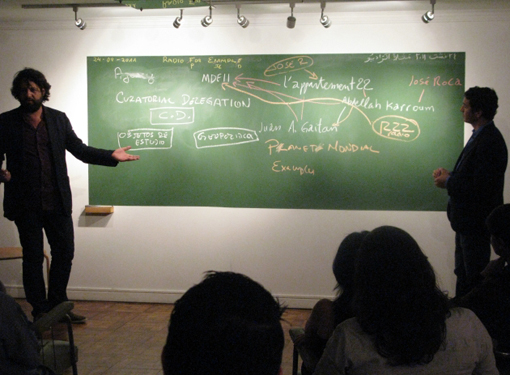
Radio For Example, presentation by the Curatorial Delegation (Juan Gaitàn and Abdellah Karroum), at MDE11, Medellin, Colombia, 2011.
More recently, during studio visits, I’ve met with a generation of artists at work who are inventing a new vocabulary. Gabriella Ciancimino, who works in Palermo (Sicily) is developing a huge project on the idea of resistance, and producing a work with a different methodology than the confined circuit of the studio to the exhibition or the market. She works on the production of flowers of resistance, using books of science and/or ideology. Another artist, Mustapha Akrim, of the same “generation ’00s”, who lives in Salé (Morocco), is also working on the idea of artwork as a moment of thinking about social life, and the relation of individuals to the constitution and the tribal organization.
GK: What’s next on your mind–another exhibition, a project, a book?
AK: I’m interested in finding ways to document the experience of the “expeditions” (1) and the “projects” conceived in and from L’appartement 22. The last ten years have been important for L’appartement 22, and they are also important for an entire generation (what I call the generation “Maroc 00s”). I am working now on how to tell, in a book, the history of the stories we witnessed in and from L’appartement 22. It is the continuation of Volume 1, but I am thinking also about the inclusion of what happened in the more public spaces. It is a book about art and artists of this generation. But it is also a tool for discussing the issues raised in a larger space of debate, not in terms of the originality of the approach of creating this space, but instead towards the continuation of its intellectual, artistic and social activities.
I am also interested in the role that writing plays in these issues, connecting artistic practices with a vocabulary for writing about art that is informed by and also contributes to this practice. As an example, as the artistic director of the Fondation Prince Pierre of Monaco, I am creating a prize for a text on art, wanting to give more recognition to this genre of work.[3] We have also worked to develop this through the laboratory “Art, Technology, Ecology” in collaboration with professional and scholarly institutions including ESAV-Marrakech, the Cinematheque of Tangier, and transit.org. The research is also continuing during the expedition we are planning with the Curatorial Delegation to explore the “offshore” oil industries’ platforms of Norway, where art was a “product” of high necessity.[4]
And, that’s a wrap!
Notes:
(2) Intense Proximity, la Triennale 2012, Palais de Tokyo. Curated by Mélanie Bouteloup, Okwui Enwezor (artistic director), Abdellah Karroum, Emilie Renard and Claire Steabler. www.latriennale.org.
(3) Artistic director of Prix International d’Art Contemporain, Prince Pierre of Monaco Foundation.
[1] The term “Formactive” is associating the “form” of the artistic vocabulary and “active” as adjective of the implied work.
[2] Jérome Schlomoff made this in preparation for a photography workshop to be held in the space.
[3] The Prize is creating a Prize for writing on art, for a text’s qualities of informing, writing and contributing to the discourse.
[4] Project in discussion among the Curatorial Delegation members, including Juan Gaitan and Abdellah Karroum, in collaboration with Anne Szefer Karlsen.


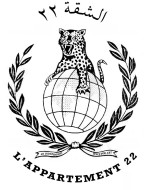
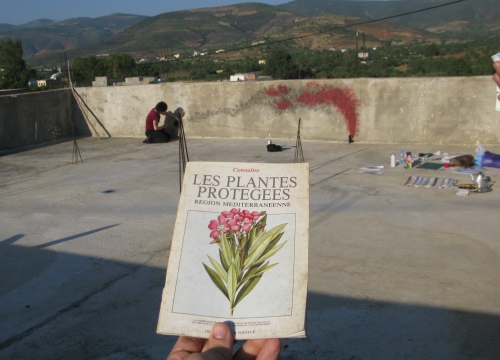
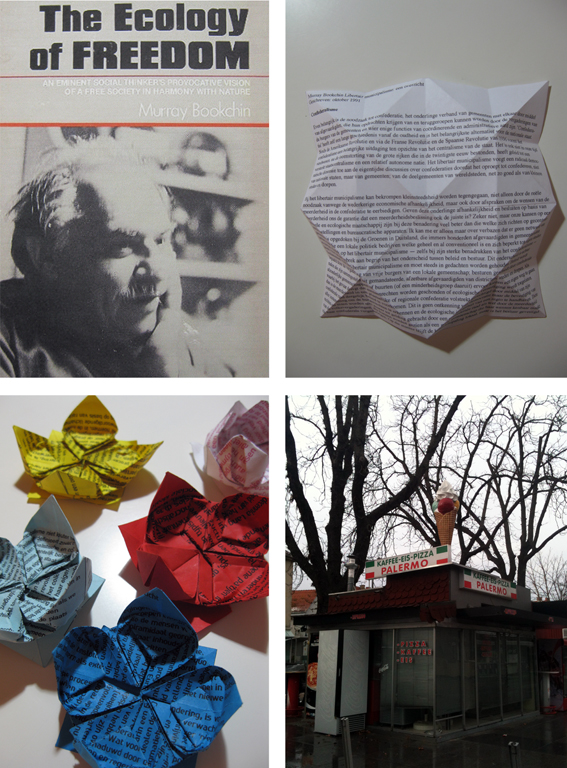



Pingback: Inside the Artist’s Studio | Abdellah Karroum | Benjamin Phillips